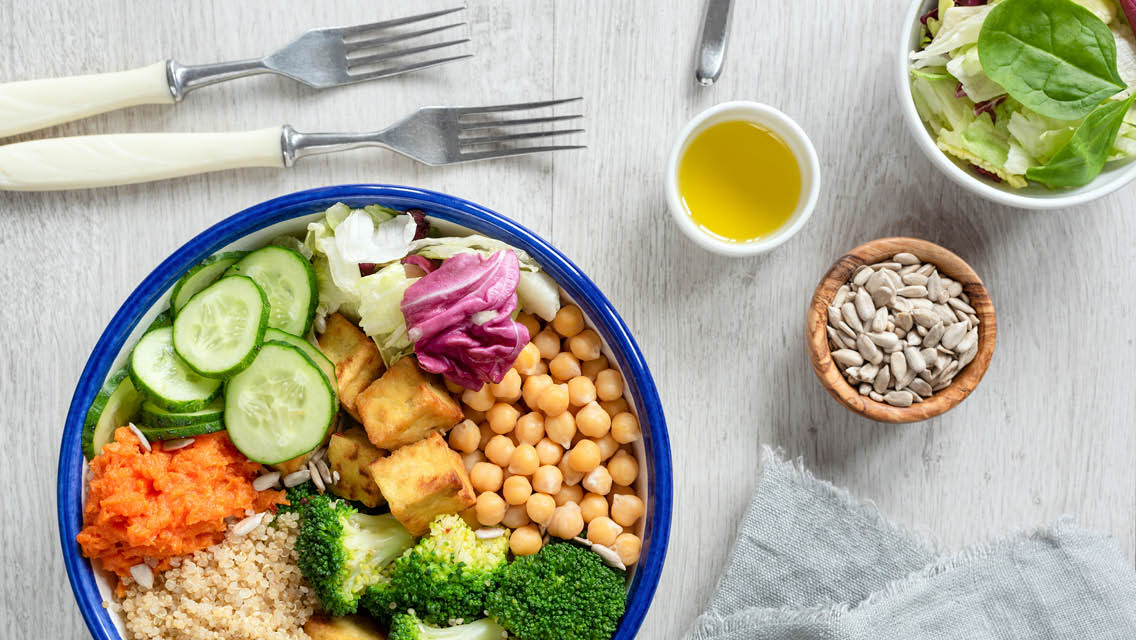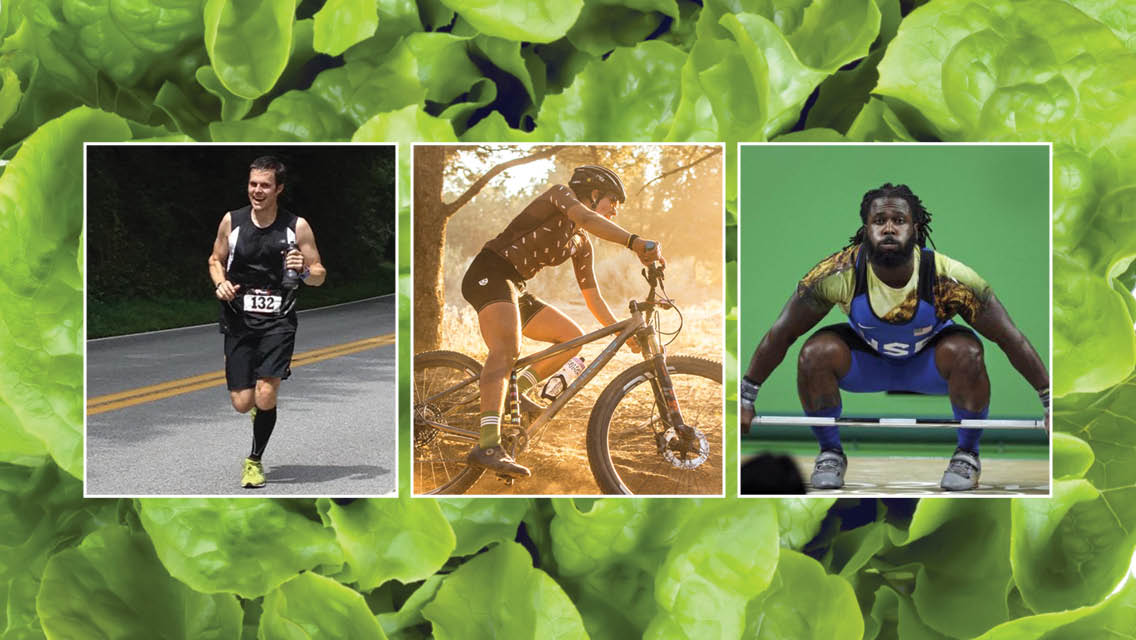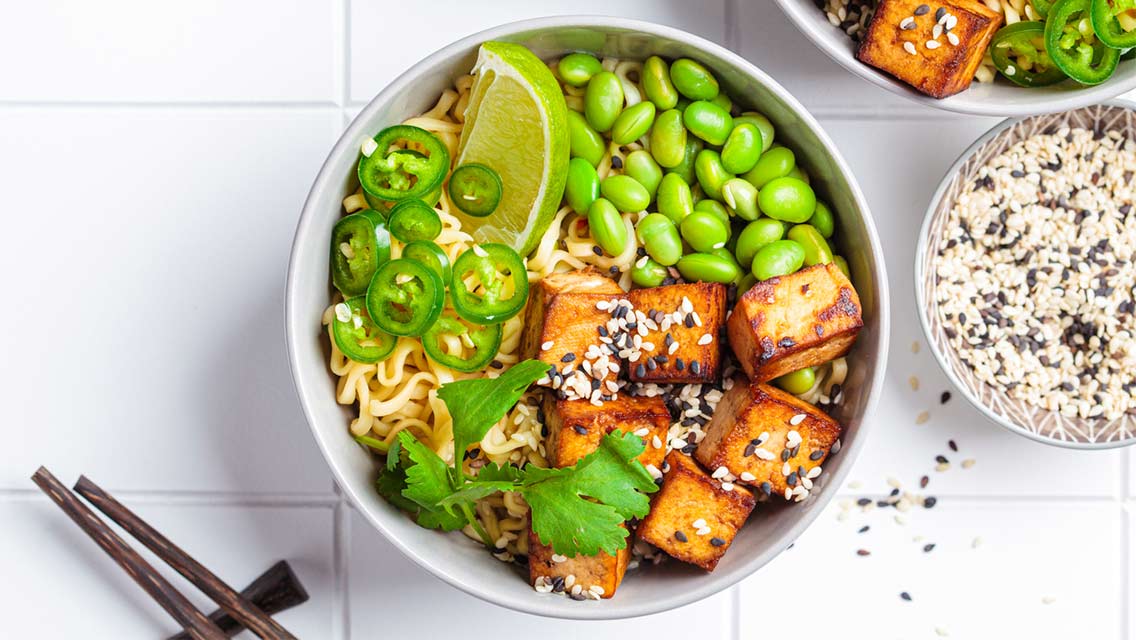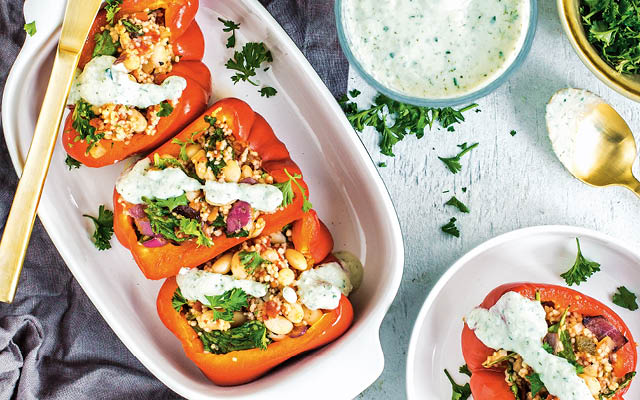Whether you choose to eat meat or not, aim to enjoy a diverse diet: It will include protein everywhere you look. Broccoli, spinach, asparagus, and sweet potatoes, for example, all contain 4 to 5 grams of protein per cooked cup.
1. Pulses
Examples of pulses | Beans, lentils, dry peas, chickpeas
Protein | 14 to 18 grams per cup, cooked
Beans, lentils, dry peas, and chickpeas have sustained populations around the globe for millennia. They are also among the most affordable, nutrient-dense, and versatile proteins on the planet.
If you’re short on time, use pulses like split peas and lentils, which cook quickly without soaking. Still, there’s no need to be intimidated by soaking beans. Lynch builds the ritual into her morning routine: “I soak beans overnight and then simmer them on the stove for an hour while I’m getting ready for the day.”
Beans and pulses also function well in disguise. Nanna Meyer, PhD, RD, CSSD, recommends making plant-forward burgers by replacing a third of the meat (ideally humanely raised) with pulses (such as lentils) and whole grains, and another third with hearty vegetables, such as carrots, kale, and beets. If you’re looking for a high-protein pasta, consider one made with chickpeas or black beans, and season it with nutritional yeast.
2. Soy Foods
Examples | Tofu, tempeh, edamame
Protein | 14 to 36 grams per cup
Soy foods contain all nine essential amino acids, along with a wealth of phytonutrients. Tofu is especially high in leucine, an amino acid key to muscle growth. Tempeh’s texture makes it satisfying as a meat replacement, and its fermentation process makes it especially easy to digest.
While there are many soy-based meat substitutes out there, it’s best to reserve them for a special treat — they often contain soy isolate, a highly processed ingredient of dubious nutritional value. (For more on plant-based meat substitutes, see “What’s Up With Fake Meat?“.)
Controversy over the breast-cancer risks posed by the phytoestrogens in soy has calmed in recent years after numerous studies concluded that they are safe. Some suggest that eating soy may even reduce the risk of breast cancer. It is, however, one of the most common food allergens, so consume soy in moderation and pay attention to how it affects you. (For more on the pros and cons of soy, see “The Pros and Cons of Eating Soy“.)
3. Whole Grains
Examples | Brown rice, quinoa, millet, teff, wild rice, steel-cut oats
Protein | 4 to 10 grams per cup, cooked
The whole grains and “pseudograins” in your grain bowl also contribute a healthy amount of protein. Lewin likes to makes a pot of quinoa (a grain-type seed) at the start of the week to use as a foundation for vegetable stir-fries.
Quinoa contains all nine essential amino acids, and it’s packed with fiber. Most American diets have insufficient fiber, which can cause a variety of gut-health issues, Lewin says, but “on a plant-based diet, getting enough fiber is not an issue.”
4. Nuts and Nutlike Legumes
Examples | Walnuts, almonds, hazelnuts, Brazil nuts, macadamia nuts, pistachios, cashews, pecans, peanuts
Protein | 9 to 38 grams per cup
Even if you’re unlikely to eat a full cup of nuts in a day, a quarter cup of nut butter can go down pretty easily, and a fistful of nuts makes a sturdy midmorning or afternoon snack.
Peanuts are technically a legume, but Americans eat them like nuts, and they’re by far the most popular, mainly in the form of peanut butter. With a whopping 7.3 grams per ounce, peanuts have more protein than any other nut.
Peanuts have more protein than any other nut.
They also provide arginine, which is considered a “semi-essential” amino acid: The body makes arginine, but a boost is especially helpful for older folks or those recovering from illness or injury. Studies show that this amino acid helps buttress the body’s immune and circulatory systems.
Still, peanuts are another common allergen, so be sure to vary your nut consumption. In addition to protein, walnuts also offer plenty of omega-3 fatty acids, and almonds supply plenty of magnesium and calcium.
5. Seeds
Examples | Hemp, pumpkin, flax, sunflower, sesame, chia
Protein | 4 to 9 grams per ounce
Seeds provide healthy fats and a slew of vitamins and minerals. Chia, hemp, and flax are all good sources of omega-3 fatty acids, especially useful for those who avoid fish.
Add seeds to smoothies or sprinkle them on salads, grain bowls, and avocado toast.
Cole loves hemp seeds. What they lack in fiber (compared with whole hemp hearts) they make up for in convenience; they are shelf-stable and easy to keep on hand. (For more on seeds, see “5 Superfood Seeds“.)
6. Nutritional Yeast
Protein | 5 grams per tablespoon
Nutritional yeast is the deactivated cousin of brewer’s and baker’s yeast, meaning it has no leavening power. The yellow flakes have a cheesy, nutty, umami-rich flavor and deliver all nine essential amino acids.
Also known as “nooch,” it often shows up in vegan recipes that call for a cheese-like flavor, but it’s an excellent condiment in its own right. Shake it over popcorn, grains, steamed vegetables, or pasta.
In addition to providing protein, nutritional yeast is also a solid source of B vitamins, including B12, and minerals, including calcium, copper, iron, phosphorus, potassium, and magnesium.
7. Plant-Protein Powder
Protein | 8 to 42 grams per serving
For athletes or anyone recovering from an illness or injury, powders can be a good source of easily assimilated protein. Look for plant-based supplements that include multiple sources, such as peas, seeds, and rice.
Horvath believes blends are more well-rounded than a single-source supplement. He notes that pea protein is a rich source of leucine, a key amino acid for muscle growth, but combining it with protein from seeds, like pumpkin and sunflower, can give the body easy access to dozens of other phytochemicals and micronutrients.
To ensure high-quality ingredients, choose a protein powder tested by a third party (preferably NSF-Certified for Sport or Informed Choice).
This was excerpted from “How to Get Enough Protein from a Plant-Based Diet” which was published in the September 2022 issue of Experience Life.





This Post Has 0 Comments